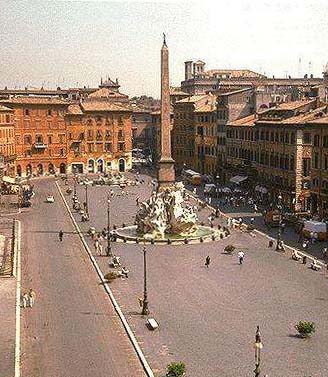|
|
 |
|
Bernini's Four Rivers Fountain |
|
written
by acz / 09.13.2004 |
|
|
| |
Introduction |
| |
| |

|
| members.aol.com/ Sokamoto31/navona.htm |
| Piazza Navona |
|
| |
|
Gian Lorenzo Bernini was born on December 7, 1598 in Naples. His father Pietro, a talented sculptor, likely introduced his son to sculpture and taught his son the basics of his craft. Considered by many scholars to have been a child prodigy, Bernini caught on quickly to his father's teachings and went on to recieve numerous commissions from various popes and other patrons of the arts.
The piece considered to be Bernini's crowning achievement is the Four Rivers Fountain located in Piazza Navona, which was created for Pope Innocent X (1644-55). The Four Rivers Fountain is a spectacular example of Baroque sculpture as well as an example of how the arts can be used as a tool for propaganda.
* * * *
In ancient Rome, what is now the Piazza Navona served as the field of Domitian's stadium for Greek foot races, circa A.D. 86. The area was also periodically flooded in order to stage re-enactments of sea battles, similar to those performed in the colosseum. Throughout the centuries the Piazza was used for festivals, various other athletic events, and as an open air market.
When Pope Innocent X came to power in the 17th century, he decided to transform the Piazza into a showcase for his family, the Pamphili's. To accomplish this aim, he hired Francesco Borromini, Bernini's rival at the time, to construct a new facade for the family's palace, to rebuild the church of Sant Agnese as a family chapel, and to enhance the Piazza's water supply. Bernini's initial role in ornamenting the Piazza was thus non-existent.
The reason for this snubbing of a man who had previously enjoyed a virtual monopoly of papal commissions under the previous pope, Urban VIII, was due to Innocent X's hostile reaction to the extravagances of the reign of Urban VIII. While he was pope, Urban VIII had raided the papal treasury, both to fund arts commissions as well as to allow his family members to enjoy an excessively high quality of life. Upon his death, Urban VIII's superfluous spending left the papacy nearly bankrupt. Innocent X's resulting animosity toward Urban VIII and the Barberini family was so great that many of Urban VIII's closer relatives found it necessary to go into exile. This hostility also extended to Bernini, who had been a favorite of the Barberini's, and Innocent X refused to have anything to do with the sculptor, thus hiring Borromini for the Piazza Navona.
In decorating the Piazza, Innocent X decided he also wanted to construct a fountain. This desire was partly logistical and partly personal. For one thing, a new conduit was needed to solve the as yet unresolved problem of where the water from the Vergine aqueduct (that fed the Trevi fountain) was to terminate. However, he also wanted a fountain of his own to overshadow the existing Barberini-commissioned fountain in the Piazza. For the commission, Innocent X invited several artists to submit design proposals for a fountain and excluded Bernini from the invitation.
However, with the help (and at the urging) of Prince Niccolo Ludovisi (a nephew of the Pope by marriage) and Donna Olimpia Maidalchini (the Pope's sister-in-law), Bernini made a model and had it displayed in a place in the palace where Innocent X would be sure to come across it. When Innocent X saw Bernini's model, he was amazed and exclaimed that "The only way to resist executing his (Bernini's) works is not to see them". Construction of the fountain commenced in 1647 and the piece was completed in 1651.
|
| |
|
| |
|
|
 |
|

